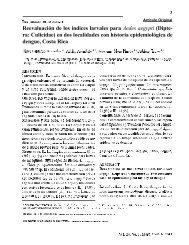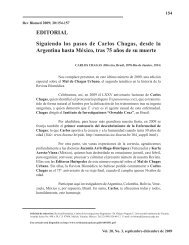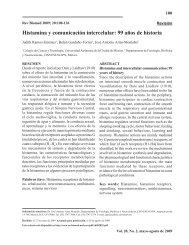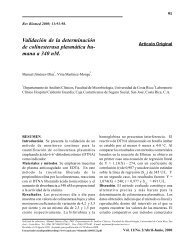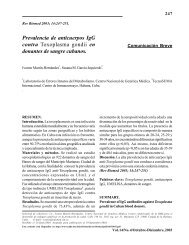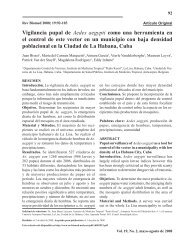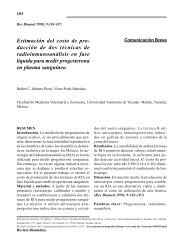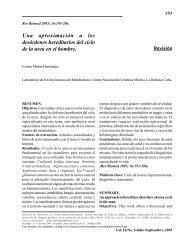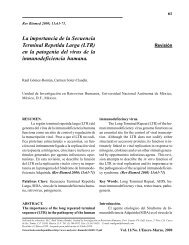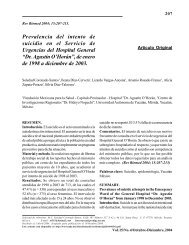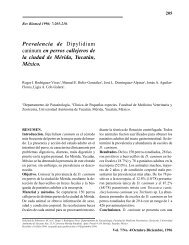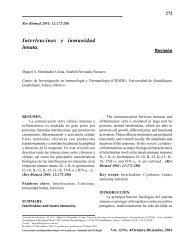Biochemical serum markers for Down syndrome screening. - Revista ...
Biochemical serum markers for Down syndrome screening. - Revista ...
Biochemical serum markers for Down syndrome screening. - Revista ...
You also want an ePaper? Increase the reach of your titles
YUMPU automatically turns print PDFs into web optimized ePapers that Google loves.
266<br />
IB Baluja-Conde, MR Rodríguez-López, O Zulueta-Rodríguez, B Ruiz-Escandón, et al.<br />
positive rate at 3.1% (positive predictive value: 1<br />
in 18) (23, 66).<br />
Pregnancy-associated plasma protein-A<br />
(PAPP-A).<br />
Pregnancy-associated plasma protein A is a<br />
large glycoprotein (MW 720,000 daltons). Its<br />
biological function is mostly unknown, although<br />
recent research has demonstrated granulose cells<br />
as a source of PAPP-A in ovaries, and suggested<br />
that PAPP-A is a marker of ovarian follicle selection<br />
and corpus luteum <strong>for</strong>mation (67). During<br />
pregnancy PAPP-A levels rise all the way to term.<br />
Reports in the early 1990s suggested that PAPP-A<br />
is reduced in pregnancies with trisomic fetuses. The<br />
deviation from normality decreases with advancing<br />
gestation (68, 69). The latter finding is compatible<br />
with reports stating that in the second trimester there<br />
is no significant difference in maternal <strong>serum</strong> PAPP-<br />
A between pregnancies with trisomy 21 and<br />
controls (70). A meta-analysis stated that median<br />
maternal <strong>serum</strong> PAPP-A level in DS pregnancies is<br />
0.35 MoM, 0.40 MoM, and 0.62 MoM at<br />
gestational weeks 6–8, 9–11, and 12–14,<br />
respectively, and 0.94 MoM thereafter. The<br />
estimated DS detection rate <strong>for</strong> a 5% false positive<br />
rate was 52% <strong>for</strong> PAPP-A alone (71).<br />
Brizot et al. studied the possible causes <strong>for</strong><br />
the decrease of PAPP-A in trisomic pregnancies.<br />
They investigated the relationship between placental<br />
messenger-RNA expression and the concentration<br />
of PAPP-A in both placental tissue and maternal<br />
<strong>serum</strong> in normal and trisomic pregnancies. The<br />
maternal <strong>serum</strong> concentration of PAPP-A in the<br />
trisomic group of pregnancies was significantly<br />
lower than in the normal controls. However, there<br />
were no significant differences in PAPP-A mRNA<br />
expression or PAPP-A protein concentration in the<br />
placental tissues. There was no significant<br />
association between the level of placental mRNA<br />
and maternal <strong>serum</strong> PAPP-A concentrations in the<br />
normal or trisomic pregnancies. These findings<br />
suggest that the decrease in maternal <strong>serum</strong> PAPP-<br />
A in trisomic pregnancies is due to alterations in<br />
<strong>Revista</strong> Biomédica<br />
post-translational events such as protein stability,<br />
alterations in the release mechanism of the protein,<br />
impaired protein transport across the placenta or<br />
modified <strong>serum</strong> stability of PAPP-A (72).<br />
The integrated method, including maternal age,<br />
NT measurement, and PAPP-A in the first trimester,<br />
and AFP, hCG, uE3, and inhibin A in the second<br />
trimester, yielded very good results, with detection<br />
rates of 94% and 85%, with false positive rates of<br />
5% and 1%, respectively (73). Two retrospective<br />
integrated studies with 321 DS cases and 15 DS<br />
cases gave detection rates of 90% and 93% with<br />
false positive rates of 5% and 5.9%, respectively<br />
(56, 74).<br />
CONCLUSIONS.<br />
<strong>Down</strong> <strong>syndrome</strong> <strong>screening</strong> has been offered<br />
to pregnant women since the early 1980s. Protocols<br />
have changed as research confirmed improvements<br />
that resulted in higher detection rates and lower<br />
false-positive rates. Screening protocols that include<br />
ultrasound measurement of nuchal translucency and<br />
biochemical testing in the first and second trimester<br />
are now available. First-trimester <strong>screening</strong> is an<br />
option if there are adequate ultrasound, diagnostic,<br />
and counselling services available. Regional variation<br />
in the availability of these services may limit the<br />
implementation of first-trimester <strong>screening</strong>.<br />
Combining <strong>screening</strong> tests <strong>for</strong> <strong>Down</strong> <strong>syndrome</strong> from<br />
both trimesters as an integrated test offers the<br />
highest detection rate with the lowest false-positive<br />
rate (table 1). Timing, detection rate, false-positive<br />
rates, and personal factors influence the decision<br />
women make regarding <strong>screening</strong> versus diagnostic<br />
testing.<br />
The integrated test, combining first-trimester<br />
sonographic and biochemical <strong>markers</strong> (free b-hCG<br />
+ PAPP-A) with second-trimester <strong>markers</strong><br />
(maternal <strong>serum</strong> alpha-fetoprotein, hCG, and uE3),<br />
provides a single estimate of patients with DS risk,<br />
and may yield a DS detection rate of 95% at a 5%<br />
false-positive rate. Many researchers have recently<br />
come up with detection rates over 90% during the<br />
first trimester using a combination of free b-hCG,



